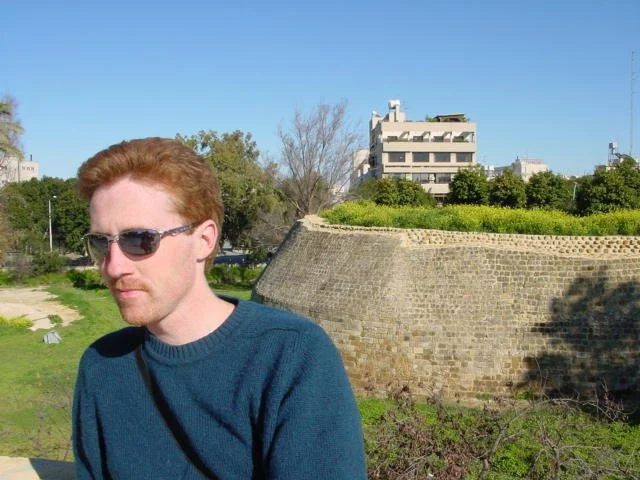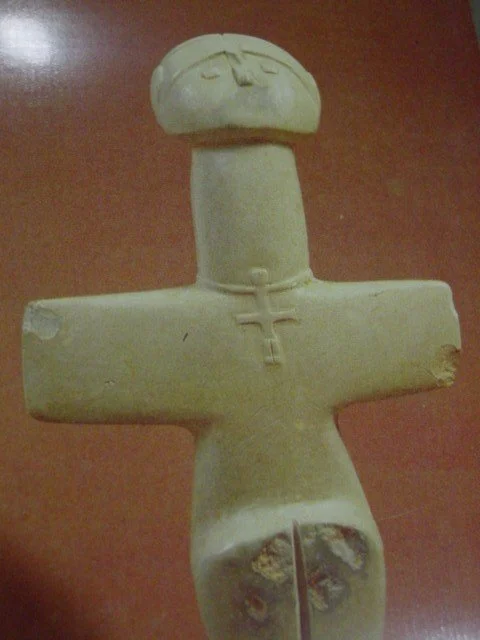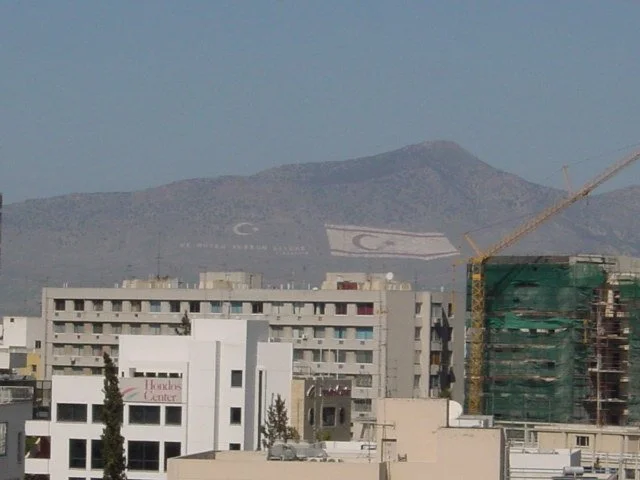March 26, 2003
The Old City walls of Nicosia.
We're doing our best to make the most of our time here. This morning we caught the bus up to the capital city, Nicosia. From the air the area known as the Old City is quite dramatic - eleven spade-shaped spokes surrounding the city. Having visited Old Cities throughout the Middle East - Jerusalem, Damascus, Nablus - we expected something similar. On the ground, though, things are much different. Wide boulevards cut through where stone walls used to stand tall. The pedestrian area looks more like West Jerusalem than Old Jerusalem. However, where it still stands, the Venetian-built wall is beautiful.
A statue that we’ve taken to called the Mascot of Cyprus.
We visited the Cyprus National Museum, a lovely bite-size piece of ancient island history. Figurines, vessels for various uses, statues, coins, and mosaics are scattered throughout. The most striking is a collection of cross-shaped figures cut from stone, one interestingly wearing a necklace of himself - from around 3500 BC. If Cyprus had a mascot, he'd be it.
Streets along the “Green Line” between Turkish and Greek Cyprus.
We went into modern Nicosia, just to the south of the city walls, to visit the offices of Sat-7. Sat-7 broadcasts programs via satellite to the Christians of the Middle East and northern Africa. Most of the filming is done in Lebanon and Egypt. We have seen some of the programming in Zababdeh. They've just recently begun broadcasting in Farsi in addition to Arabic, and are now looking to begin in the Moroccan dialect of Arabic and in Turkish. It's a large operation which took a big hit after September 11th. It's also an important ministry in this part of the world.
After lunch there, we headed back to the Old City towards the Archbishop's Palace to see their collection of icons. The time of the Turkish control of the northern section of the island - which began in 1974 - has been destructive to the Christian treasures there. Many churches were simply looted, with icons and mosaics finding their way to antiques dealers in Europe. Quite a few have been recovered, but quite a few have been permanently lost, too. There is great resentment of the Turks by the Greek Cypriots. The cease fire line runs right through the middle of the Old City, the UN patrolling between the two sides.
The Turkish side of Nicosia.
We walked along the so-called Green Line, where barrels have been propped up and filled with dirt, big signs announcing the demilitarized zone, forbidding photographs. Here, a house is inhabited and full of life. There, the windows are gone and sandbags are stacked high. One neighbor has stayed put, the other has been forced to leave. War is cruel and arbitrary when it comes to the lives of everyday folks.
The Turkish flag decorates the hillside in the distance.
We climbed the observation tower to get a look over the city. On the hills just to the north, the Turks have painted two flags: one of Turkey, the other of Turkish Cyprus. They are ominous in their presence. Ancient history and clashes between Greeks and Turks are still very present.
As we caught the bus back to Limassol, we got a message from Fr. Firas. Construction is continuing on the Melkite Church back home: "alamenum wimdows wil finshe in ten days electric in tw days."





